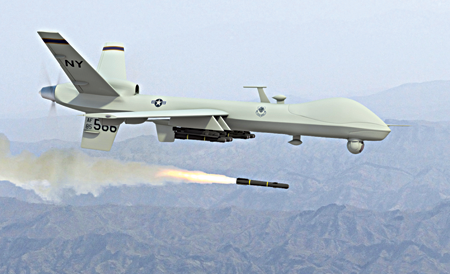“The level of intelligence varies from robot to robot, depending on the mission the robot is used for. A robot must at least be able to operate autonomously to the extent that the soldier can concentrate on the task at hand. It should act as a tool to reduce his load and not as a burden and technology barrier. In general, robots need not be highly intelligent but have to be smart, simple to use and maintain,” opines Azad.
‘Intelligence’ in robotics is a very loosely-used term, but generally it revolves around the way a system responds to the feedback from the external environment and changes. Another challenge is the processing of data captured from various sensors used in the robot. In all cases, time in the order of milliseconds is of the highest priority, as lives depend on the response of these systems.
Nowadays, extremely complex software systems are being developed to improve the intelligence of robots. However, as far as military robots go, any such technology has to be tested time and again to prove its reliability before deployment because it is a matter of lives.

“Robots in defence, like the KMAX, surely have extremely high levels of intelligence. Their learning algorithms are extremely effective, using various machine learning techniques. Most of these techniques are based on probabilistic models developed. Intelligence, in essence, is the development of the ‘brain’ of the robot and there is vast ongoing research on this topic. There are various windows through which these problems can be approached, like neural networks and machine learning,” says Pitchai.
“Slowly but surely we are getting there as a robotics community, but there is a long way to go before we can actually call a system ‘intelligent.’ Most UAVs used in defence have some such capabilities, but to be actually used on a large scale the research and the results have to be rock solid, which will require many years of research,” explains Pitchai.
Jayakrishnan adds that while today’s robots are intelligent enough for surveillance, information gathering and even bomb detonation, these are still not capable of strategic decision-making.
Other interesting trends
“One ultimate robotic technology we see today is task-level robot control,” says Jayakrishnan. For example, state-of-the-art control software can be used to tell a robot to ‘grab an object’ rather than excercising cumbersome manual control throughout the task.
“This may sound easy, since even a young child can grab an object, but it has been very difficult to give a robot the right combination of visual understanding, intelligence and grasping control. Such advanced perception and grasping capabilities enable the handling and operation of any sophisticated battlefield equipment and system,” Jayakrishnan explains.
Another key development is use of robots to perform tele-surgery at the warfront under the control of expert surgeons operating from a distance. With haptic/force feedback devices and real-time visual information, the surgeons are virtually transported to the actual environment.
“There are many new ideas coming into play. Especially, in the areas of SWARM robotics, where robots can communicate with each other during warfare and help soldiers further. UAVs are vastly improving and with the advent of quadrotors these are further developing and improving,” adds Pitchai.
A quadrotor is a kind of multicopter propelled by four rotors. While this technology has been used in aircrafts since the early 1920s, of late it has found place in UAV technology.
University of Pennsylvania’s GRASP Lab has developed quadrotors that can fly through windows and rings, hit balls, etc. They recently managed to get groups of the robots to fly together in a formation. As in the case of fighter jets, there is a leader robot in each squad along with several follower robots. The followers have just two jobs—follow the leader and preserve the shape of the formation. This might be very useful to develop robots trained in modern warfare tactics.
How stiff is the competition?
Robots are doing well in the military. There is no fear of death in the back of their minds. They are designed to handle bad weather and tough terrains, and can carry weight. But does this mean robots will one day replace soldiers in war? Certainly not!
Shekhar gives a spirited reply: “It’s been more than three decades since desktops revolutionised computing and other IT industries. The same question was asked before about whether computers would replace humans and whether we would just be sitting and watching them do everything. We still have our jobs and responsibilities, but in a better way. I do not believe that these machines can ever completely replace us as we are the soul of these machines.”
Machines can compute really fast but when it comes to taking critical decisions they need soul to help them. So these can get better, faster and more reliable only in the presence of humans. Similarly, in a warfield, robots need to take critical and real-time decisions most of the time and this can happen only under the guidance of a human present there. It is neither advisable nor practical to let these robots fight all by themselves as it is next to impossible to clone the beauty and intelligence of the human brain into these machines.”
The author is a technically-qualified freelance writer, editor and hands-on mom based in Chennai






